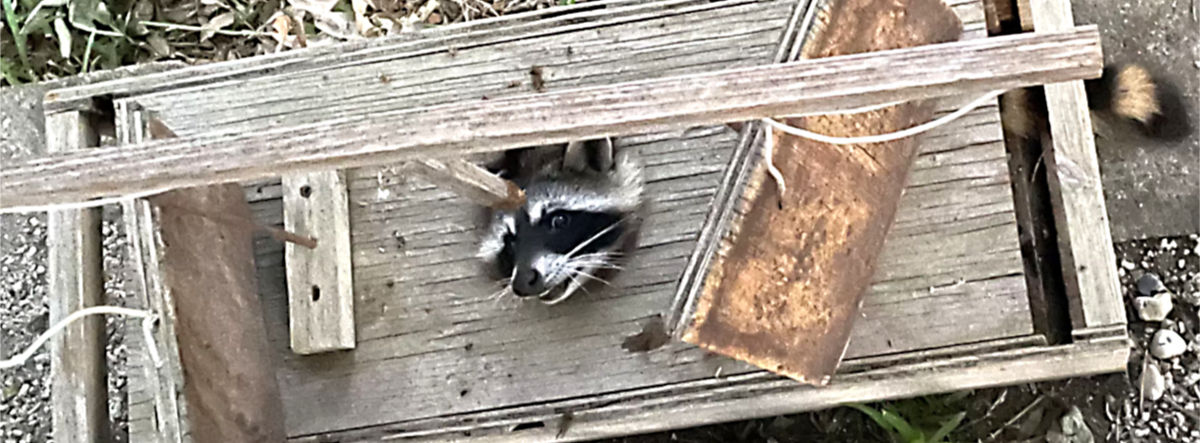Yesterday before church I was swapping critter trapping stories with a couple of guys, and we landed on the subject of inadvertently catching different animals than we intended to trap. More specifically, we shared stories about trapping skunks instead of the targeted raccoons or armadillos.
Over the years, I’ve had both of those varmints wander into an armadillo trap, but releasing them has never been much of an issue. Even the skunks were sanguine about the catch-and-release, other than doing a bit of chewing on part of the trap. But until this morning, I had not had a truly trapped animal in the trap. This photo will show you what I mean by that:

This is the top view of our armadillo trap. The trap’s “trigger” (basically a stick on a string) hangs down into the hole on top (which is currently filled with a raccoon head). When an armadillo wanders into the trap, it bumps the trigger, dropping the doors on both ends, thus blocking the exits.
In this case, a raccoon sprung the trap, but instead of banging around inside the box and eventually going to sleep, as armadillos and skunks do, it sought to escape through the hole on top, and in so doing, its head became stuck. I have no idea how long it remained in that position, but it was not a happy camper when I found it around 6:30 this morning. (Note that in this photo, I’ve propped both doors open; you can see the raccoon’s tail sticking out of the right end of the trap.)
Here’s another photo, taken through the bars of our fence. You might notice that the raccoon has one paw under its chin, which I suspect was just enough to keep it from being able to back its head out of the hole.

I tapped gently on the top of its head with a stick, hoping that would motivate it to back out and exit the trap, but all I succeeded in doing was eliciting an angry hiss. I decided to leave it alone for a while, in hopes that if it wasn’t stressed by my presence, it might relax enough to extricate itself. We went for a bike ride, and when we returned the trap was empty, except for a note swearing vengeance. Raccoons have surprisingly legible handwriting, by the way.
I was relieved that I wasn’t going to have to decapitate a raccoon in order to set it free, as that didn’t seem like an equitable trade, especially for the raccoon.

Also this morning, before sunrise, I was in the kitchen getting a cup of coffee when something caught my eye through the dining room window. Or, rather, on the dining room window. “That’s a huge moth,” I thought, and I couldn’t tell at first whether it was inside or outside.
As I walked over to the window, my razor-sharp senses informed me that (1) it was outside, and (b) it was no moth. And my extensive zoological training and expertise allowed me to immediately identify it as a frog. But which frog?
Welp, who knows? It’s either a gray tree frog (Dryophytes versicolor) or a Cope’s gray tree frog (Dryophytes chrysoscelis). Again, who knows? Both have similar ranges. Both have similar calls. Their physical appearances are practically identical, distinguished from other species by the yellow-orange patches on their hind legs, as shown in the photo I took this morning:

In fact, it appears that the only foolproof way to distinguish between the two species is to do a chromosomal analysis. D. chrysoscelis is diploid, meaning that it has two sets of chromosomes, one set from each parent, while D. versicolor is tetraploid, so it has four sets of chromosomes.
I find it somewhat interesting that like D. chrysoscelis, humans are diploid, which puts a whole new spin on the episode of Everybody Loves Raymond wherein Raymond’s brother Robert falls for a lovely young woman, only to learn that she’s got a strange fascination with frogs, and an equally strange view of human evolution, as evidenced in this short clip:
On the other hand, D. versicolor‘s tetraploidism puts it in the same category as salmon, an Argentinian rat, and…cotton. Ain’t genetics da bomb?
Well, anyway…I’ve apparently misplaced my AmScope 120X-1200X 52-pcs Kids Beginner Microscope STEM Kit with Metal Body Microscope and thus was unable to perform the required chromosomal analysis to confirm the identity of our window-sucking amphibian. But we’re having salmon for dinner tonight, and I can do without certain mental images, so I’m going with D. chrysoscelis.
I can’t wait to see what (or who) visits us tonight.

The More You Know…

Discover more from The Fire Ant Gazette
Subscribe to get the latest posts sent to your email.

